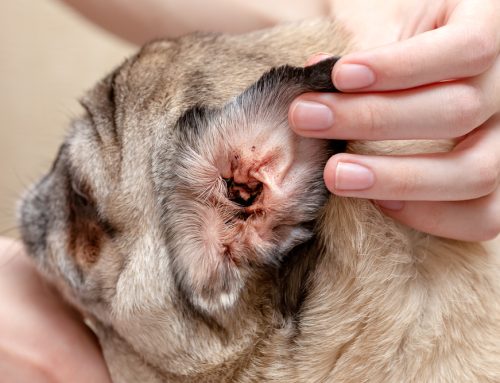As pet lovers, we all want the same thing for our dogs and cats—longer lives. While the fountain of woof—er, youth—hasn’t yet been found, Countryside Veterinary Hospital has prepared an easy-to-follow road map that can help you add years to your pet’s life through the choices you make every day.
#1: Take your pet to the veterinarian every year
Although we provide exceptional care for sick and injured pets, we’d rather be known for our top-level preventive medicine. When our veterinarians examine your pet during their healthy years, they can minimize their risk for infectious disease, illness, and chronic conditions. Getting to know your pet’s normals while they are healthy also helps us to identify early warning signs—potentially months or years before they manifest themselves as visible disease.
Don’t press pause on your pet’s annual care after their spay or neuter surgery—their annual visit includes:
- Full nose-to-tail physical examination
- Body condition and weight assessment
- Lifestyle-based vaccinations to boost the immune system and safeguard health
- Infectious diseases and harmful parasite screening tests
- Early detection of physical changes or microscopic biomarkers to catch disease months or years before you may notice a problem.
#2: Keep an eye on your pet’s dental health
Dental disease affects the majority of pets by age 3. In addition to pain from damaged teeth, infection, and inflammation, dangerous oral bacteria can enter your pet’s bloodstream and permanently injure their heart, kidneys, liver, and lungs.
Because dental disease lies mostly below the gum line, you probably won’t notice until your pet is severely affected. The only way to prevent and address this silent suffering is a multi-step routine that includes:
- Daily home care — Our team can help you learn effective toothbrushing techniques, and make specific product recommendations for dental chews, diets, and treats.
- Annual check-up — We look for changes in gum health or visibly damaged or fractured teeth.
- Dental cleaning and X-rays under anesthesia — While yearly dental cleanings are ideal, our veterinarians will recommend a specific schedule for your pet, based on their oral health.
#3: Defend your pet with veterinarian-recommended parasite prevention
Parasites are more than a disgusting nuisance—infection or infestation can lead to illness, weakness, and discomfort, or transmit deadly heartworm disease—which affects both dogs and cats. Many parasites—including hookworms, roundworms, fleas, ticks, and mites—can also be transmitted to people. Intestinal parasites can cause potentially life-threatening illness and anemia in small puppies and kittens.
Year-round parasite prevention is essential for all pets—including those who live exclusively indoors. Because of climate changes, wildlife migration, and the high-volume transportation of shelter pets, parasite feeding seasons and populations are expanding into new regions—and bringing their diseases. But, thanks to safe, effective, and easy to use products, a strong defense against parasites is simpler than ever—ask your Countryside Veterinary Hospital veterinarian for product recommendations.
#4: Watch your pet’s waistline
Your pet may not need to worry about their beach body or how their harness looks when they sit down, but their body weight directly correlates to their overall health. Excess adipose tissue (i.e., fat) creates an inflammatory state in the body, and increases your pet’s risk for many life-shortening conditions, including:
- Cancer
- Arthritis
- Kidney failure
- Orthopedic injury (e.g., cruciate rupture or ACL tear)
- Endocrine diseases (e.g., diabetes, hypothyroidism)
- Skin disorders
- Respiratory problems
In one lifetime study, dogs who were fed a portion-controlled diet (i.e., no more than their daily required calories) lived almost two years longer than unrestricted free-fed dogs. While this study was performed only in dogs, the results would likely be similar for cats.
Pet weight management is a continual balance of calories consumed—ideally from wholesome, complete, and balanced nutrition—and calories burned through physiological processes and physical exercise. Daily actions to keep your pet in shape include:
- Assessing their weight — This hands-on skill can tell you more about their health than a number on the scale.
- Measuring their food — Calculate your pet’s daily calories and provide measured meals two to three times per day.
- Feeding a healthy diet — Food is fuel for your pet’s body and mind. Select a diet that meets the American Association of Feed Control Officials (AAFCO) nutrient profiles, and has been tested in formal feeding trials to ensure efficacy and safety.
- Consulting the experts — Ask your veterinarian for pet diet recommendations, help with calculating your pet’s caloric needs and portion size, or how to help your pet safely lose weight.
Pet nutritional needs change during each life stage, so we’ll review your current nutrition plan at each wellness visit.
#5: Train and exercise your pet regularly

Behavior problems are the primary reason pets are surrendered to shelters, and the number one cause of euthanasia in pets under 3 years old. Proper socialization, training, and adequate daily exercise make pets easier to live with and less likely to behave inappropriately. Additional benefits include:
- Weight management
- Mental stimulation
- Decreased arthritis risk
- Improved pet-owner bond
As much as we’d like to, we can’t promise your pet will live forever—but we can help you improve the quality and quantity of their days. Simple daily choices, such as taking a walk instead of having a snack, or setting a reminder to give monthly heartworm prevention, can give you and your pet the gift of extra time together. Perhaps the fountain of woof isn’t a place after all—it’s proactive pet ownership and preventive care at Countryside Veterinary Hospital. Contact us to schedule your pet’s next wellness appointment.








Leave A Comment